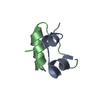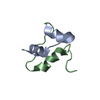+ Open data
Open data
- Basic information
Basic information
| Entry | Database: PDB / ID: 7qac | |||||||||
|---|---|---|---|---|---|---|---|---|---|---|
| Title | The T2 structure of polycrystalline cubic human insulin | |||||||||
 Components Components |
| |||||||||
 Keywords Keywords | HORMONE / cubic / human / insulin / T2 | |||||||||
| Function / homology |  Function and homology information Function and homology informationnegative regulation of NAD(P)H oxidase activity / negative regulation of glycogen catabolic process / positive regulation of nitric oxide mediated signal transduction / negative regulation of fatty acid metabolic process / negative regulation of feeding behavior / Signaling by Insulin receptor / IRS activation / Insulin processing / regulation of protein secretion / positive regulation of peptide hormone secretion ...negative regulation of NAD(P)H oxidase activity / negative regulation of glycogen catabolic process / positive regulation of nitric oxide mediated signal transduction / negative regulation of fatty acid metabolic process / negative regulation of feeding behavior / Signaling by Insulin receptor / IRS activation / Insulin processing / regulation of protein secretion / positive regulation of peptide hormone secretion / positive regulation of respiratory burst / negative regulation of acute inflammatory response / Regulation of gene expression in beta cells / alpha-beta T cell activation / regulation of cellular amino acid metabolic process / negative regulation of respiratory burst involved in inflammatory response / positive regulation of dendritic spine maintenance / positive regulation of glycogen biosynthetic process / Synthesis, secretion, and deacylation of Ghrelin / negative regulation of protein secretion / regulation of protein localization to plasma membrane / fatty acid homeostasis / Signal attenuation / negative regulation of lipid catabolic process / negative regulation of gluconeogenesis / FOXO-mediated transcription of oxidative stress, metabolic and neuronal genes / COPI-mediated anterograde transport / positive regulation of lipid biosynthetic process / negative regulation of reactive oxygen species biosynthetic process / negative regulation of oxidative stress-induced intrinsic apoptotic signaling pathway / positive regulation of insulin receptor signaling pathway / nitric oxide-cGMP-mediated signaling / transport vesicle / positive regulation of protein autophosphorylation / Insulin receptor recycling / insulin-like growth factor receptor binding / neuron projection maintenance / NPAS4 regulates expression of target genes / positive regulation of protein metabolic process / positive regulation of brown fat cell differentiation / activation of protein kinase B activity / endoplasmic reticulum-Golgi intermediate compartment membrane / positive regulation of glycolytic process / positive regulation of mitotic nuclear division / Insulin receptor signalling cascade / positive regulation of nitric-oxide synthase activity / positive regulation of cytokine production / positive regulation of long-term synaptic potentiation / acute-phase response / Regulation of insulin secretion / negative regulation of protein catabolic process / endosome lumen / positive regulation of glucose import / positive regulation of protein secretion / negative regulation of proteolysis / positive regulation of cell differentiation / regulation of transmembrane transporter activity / insulin receptor binding / wound healing / regulation of synaptic plasticity / vasodilation / hormone activity / cognition / positive regulation of neuron projection development / positive regulation of protein localization to nucleus / Golgi lumen / glucose metabolic process / regulation of protein localization / glucose homeostasis / insulin receptor signaling pathway / cell-cell signaling / PI5P, PP2A and IER3 Regulate PI3K/AKT Signaling / positive regulation of NF-kappaB transcription factor activity / positive regulation of cell growth / protease binding / secretory granule lumen / positive regulation of MAPK cascade / positive regulation of phosphatidylinositol 3-kinase/protein kinase B signal transduction / positive regulation of cell migration / G protein-coupled receptor signaling pathway / Amyloid fiber formation / Golgi membrane / endoplasmic reticulum lumen / negative regulation of gene expression / positive regulation of cell population proliferation / positive regulation of gene expression / regulation of DNA-templated transcription / extracellular space / extracellular region / identical protein binding Similarity search - Function | |||||||||
| Biological species |  Homo sapiens (human) Homo sapiens (human) | |||||||||
| Method | POWDER DIFFRACTION /  SYNCHROTRON / SYNCHROTRON /  MOLECULAR REPLACEMENT / Resolution: 2.29 Å MOLECULAR REPLACEMENT / Resolution: 2.29 Å | |||||||||
 Authors Authors | Karavassili, F. / Triandafillidis, D.P. / Valmas, A. / Spiliopoulou, M. / Fili, S. / Kontou, P. / Bowler, M.W. / Von Dreele, R.B. / Fitch, A. / Margiolaki, I. | |||||||||
| Funding support | European Union,  Greece, 2items Greece, 2items
| |||||||||
 Citation Citation |  Journal: Acta Crystallogr D Struct Biol / Year: 2023 Journal: Acta Crystallogr D Struct Biol / Year: 2023Title: The T 2 structure of polycrystalline cubic human insulin. Authors: Triandafillidis, D.P. / Karavassili, F. / Spiliopoulou, M. / Valmas, A. / Athanasiadou, M. / Nikolaras, G. / Fili, S. / Kontou, P. / Bowler, M.W. / Chasapis, C.T. / Von Dreele, R.B. / Fitch, ...Authors: Triandafillidis, D.P. / Karavassili, F. / Spiliopoulou, M. / Valmas, A. / Athanasiadou, M. / Nikolaras, G. / Fili, S. / Kontou, P. / Bowler, M.W. / Chasapis, C.T. / Von Dreele, R.B. / Fitch, A.N. / Margiolaki, I. | |||||||||
| History |
| |||||||||
| Remark 1 | REMARK 250 REFINEMENT. REMARK 250 PROGRAM : GSAS REMARK 250 AUTHORS : LARSON & VON DREELE REMARK ... REMARK 250 REFINEMENT. REMARK 250 PROGRAM : GSAS REMARK 250 AUTHORS : LARSON & VON DREELE REMARK 250 REMARK 250 DATA USED IN REFINEMENT REMARK 250 RESOLUTION RANGE HIGH (ANGSTROMS) : 2.29 REMARK 250 RESOLUTION RANGE LOW (ANGSTROMS) : 39.43 REMARK 250 POWDER DIFFRACTION DATA. REMARK 250 REMARK 250 FIT TO DATA USED IN REFINEMENT REMARK 250 NUMBER OF POWDER PATTERNS : 6 REMARK 250 PROFILE R VALUES (%) : 7.70 11.54 12.16 8.80 7.61 2.12 REMARK 250 WEIGHTED PROFILE R VALUES (%) : 10.98 14.75 15.17 12.12 10.95 3.34 REMARK 250 F**2 R VALUES (%) : 42.02 38.68 44.09 38.89 35.52 24.00 REMARK 250 NUMBERS OF POWDER PATTERN POINTS : 8256 7003 7002 7002 7002 4740 REMARK 250 NUMBERS OF REFLECTIONS : 3816 2345 2349 2345 2305 4998 REMARK 250 TOTAL NUMBER OF POWDER POINTS : 41005 REMARK 250 REMARK 250 NUMBER OF NON-HYDROGEN ATOMS USED IN REFINEMENT. REMARK 250 PROTEIN ATOMS : REMARK 250 NUCLEIC ACID ATOMS : REMARK 250 HETEROGEN ATOMS : REMARK 250 SOLVENT ATOMS : REMARK 250 REMARK 250 MODEL REFINEMENT. REMARK 250 NUMBER OF LEAST-SQUARES PARAMETERS : 786 REMARK 250 NUMBER OF RESTRAINTS : 1951 REMARK 250 LEAST-SQUARES MATRIX BAND WIDTH : 50 REMARK 250 MARQUARDT COEFFICIENT : 8.30 REMARK 250 REMARK 250 RMS DEVIATIONS FROM RESTRAINT TARGET VALUES. NUMBER. REMARK 250 INTERATOMIC DISTANCES (A) :0.015 506 REMARK 250 BOND ANGLES (DEG) : 1.43 702 REMARK 250 CHIRAL VOLUMES (A**3) :0.036 52 REMARK 250 TORSION ANGLE RESTRAINTS (E) : 1.00 98 REMARK 250 DISTANCES FROM RESTRAINT PLANES (A) :0.020 149 REMARK 250 TORSION PSEUDOPOTENTIAL RESTRAINTS (E) : 3.84 68 REMARK 250 ANTI-BUMPING DISTANCE RESTRAINTS (A) :0.123 186 REMARK 250 HYDROGEN BOND DISTANCE RESTRAINTS (A) :0.293 212 |
- Structure visualization
Structure visualization
| Structure viewer | Molecule:  Molmil Molmil Jmol/JSmol Jmol/JSmol |
|---|
- Downloads & links
Downloads & links
- Download
Download
| PDBx/mmCIF format |  7qac.cif.gz 7qac.cif.gz | 24.4 KB | Display |  PDBx/mmCIF format PDBx/mmCIF format |
|---|---|---|---|---|
| PDB format |  pdb7qac.ent.gz pdb7qac.ent.gz | 10.2 KB | Display |  PDB format PDB format |
| PDBx/mmJSON format |  7qac.json.gz 7qac.json.gz | Tree view |  PDBx/mmJSON format PDBx/mmJSON format | |
| Others |  Other downloads Other downloads |
-Validation report
| Summary document |  7qac_validation.pdf.gz 7qac_validation.pdf.gz | 347.2 KB | Display |  wwPDB validaton report wwPDB validaton report |
|---|---|---|---|---|
| Full document |  7qac_full_validation.pdf.gz 7qac_full_validation.pdf.gz | 352.7 KB | Display | |
| Data in XML |  7qac_validation.xml.gz 7qac_validation.xml.gz | 3.4 KB | Display | |
| Data in CIF |  7qac_validation.cif.gz 7qac_validation.cif.gz | 4.5 KB | Display | |
| Arichive directory |  https://data.pdbj.org/pub/pdb/validation_reports/qa/7qac https://data.pdbj.org/pub/pdb/validation_reports/qa/7qac ftp://data.pdbj.org/pub/pdb/validation_reports/qa/7qac ftp://data.pdbj.org/pub/pdb/validation_reports/qa/7qac | HTTPS FTP |
-Related structure data
| Related structure data |  9insS S: Starting model for refinement |
|---|---|
| Similar structure data | Similarity search - Function & homology  F&H Search F&H Search |
- Links
Links
- Assembly
Assembly
| Deposited unit | 
| ||||||
|---|---|---|---|---|---|---|---|
| 1 |
| ||||||
| Components on special symmetry positions |
|
- Components
Components
| #1: Protein/peptide | Mass: 2383.698 Da / Num. of mol.: 1 Source method: isolated from a genetically manipulated source Source: (gene. exp.)  Homo sapiens (human) / Gene: INS / Production host: Homo sapiens (human) / Gene: INS / Production host:  |
|---|---|
| #2: Protein/peptide | Mass: 3433.953 Da / Num. of mol.: 1 Source method: isolated from a genetically manipulated source Source: (gene. exp.)  Homo sapiens (human) / Gene: INS / Production host: Homo sapiens (human) / Gene: INS / Production host:  |
| #3: Water | ChemComp-HOH / |
-Experimental details
-Experiment
| Experiment | Method: POWDER DIFFRACTION / Number of used crystals: 6 |
|---|
- Sample preparation
Sample preparation
| Crystal |
| |||||||||||||||||||||||||||||||||||||||||
|---|---|---|---|---|---|---|---|---|---|---|---|---|---|---|---|---|---|---|---|---|---|---|---|---|---|---|---|---|---|---|---|---|---|---|---|---|---|---|---|---|---|---|
| Crystal grow |
|
 Movie
Movie Controller
Controller



 PDBj
PDBj

















